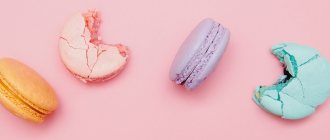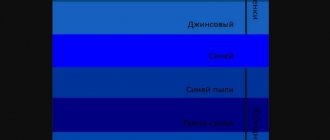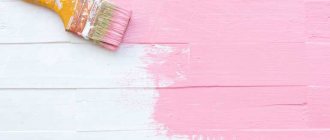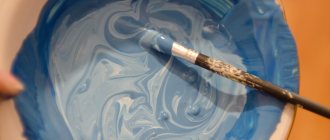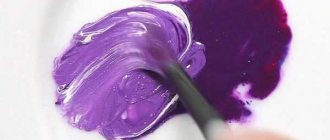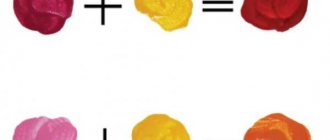» How to get color » How to get gray by mixing paints
How to get gray color and its shades by mixing it with different colors in 9 pictures that will clearly show the tones and the process of combining them. We will build warm and cool gray colors such as mouse, anthracite, morengo and others. There is nothing simpler than gray, however, this shade, as a neutral one, is quite often used in fine art, not in its pure form, but with various answers. It has a lot of undertones, and the range from light to dark is also wide, so mixing the right gray color can sometimes be quite difficult.
How to get gray: mix black and white
Gray color is obtained by mixing white and black, but this proportion cannot be one to one. To get a medium gray tone you need to take at least 5 parts white and 1 (one) black. In practice, it will look like this: squeeze a pea of white paint onto the palette and 3 times less black next to it, then carefully take it on the tip of the brush and dip it into white. By adding drops of dark color to white, you can adjust the degree of darkening of the gray color.
The colors obtained in this way will be “pure” and are the basis for further mixing to acquire any undertone.
Shades of yellow
These include not only light and dark yellow, but also beige, golden, bronze, wax, lemon, amber, khaki, ocher, apricot and others.
- Golden - considered the main color in Orthodox icon painting. It is a brilliant yellow shade.
- Apricot is a yellowish-straw shade.
- Bronze is a golden brown or dark yellow with a sheen.
- Waxy - light yellow, pale shade.
- Khaki is green-yellow, with a predominance of green.
- Lemon is a bright yellow with a light green tint.
When purchasing paint at a hardware store, you will notice that each manufacturer gives the shades they produce their own names.
. For example, golden harvest, golden palm, narcissus, Incan gold, etc. They achieve a new shade by mixing certain colors in different proportions.
How to get olive drab color
If you need to paint a shadow cast by greenery on a sunny day, then an olive-gray shade would be ideal. This is a warm, neutral khaki, which is obtained by mixing an existing gray shade with a drop of yellow. Mixing it on the palette will look like this: in front of you is already mixed black and white paint, squeeze out a small amount of yellow paint nearby (about the same amount as black) and add it to the gray with a brush stroke. To create an undertone you need a minimal amount of paint. It is worth considering that yellow is a light paint, so if you have precisely selected the lightness of gray, the resulting shade will be a little lighter than planned.
Characteristics of green color
Green is considered a universal color because it goes with all tones. This is a second-order shade formed by mixing blue and yellow.
Green color is credited with the properties of calming the body, normalizing blood pressure, relieving visual fatigue, and relieving negative thoughts and stress.
How to get anthracite tone
Anthracite is a dark shade of gray with a purple undertone. To obtain it, you will need a ready-made, mixed gray color, red and blue, where it is better to take red carmine, and blue – ultramarine. This way you get two composite colors: the main one, which we focused on, and an additional one - purple, which, if it is in the palette, you can take ready-made. We mix tones with a predominance of gray. It is worth taking into account the fact that purple darkens the main tone, so in order to get lighter tones, the mixture will need to be diluted with white.
Getting the result
Sometimes, in order to select the required shade of the final decorative coating, a person goes around a dozen hardware stores, but the search for the desired result is unsuccessful and the expected results are not obtained.
If you blindly follow the color mixing table, then it is enough to buy two or three colors, primary, substrate or with the absence of a chromatic component, so that when mixed you get the necessary options. After all, according to this table, it’s so easy to find the desired shade:
- mix with white - reduce the intensity of the tone;
- to get pink - take white and red;
- make red by mixing red and yellow;
- stir up purple by mixing blue and red;
- Mix yellow and blue and see the coveted green.
If the right colors were obtained with such enviable ease as in a children's coloring book with watercolors and brushes, there would be no problems with finding the right shade. But the result of mixing depends on what kind of red (red (red, burgundy, scarlet, dark red)) and on what kind of blue (indigo, azure, dark blue, ultramarine). It depends on what kind of paint is taken and even a mixture of different bases - everything can lead to getting the wrong shade that is required.
The resulting desired tone may change due to exposure to air, sunlight and the surface on which it is applied. Moreover, the subjectivity of the human factor, visual defects and the refraction of light at certain times of the day play a role. And so, of course, yes, blue and red when mixed give a simple violet color (velvet violet, dark violet, lilac, purple, etc.).
Harmonious color combination (1 video)
Rooms in blue and red colors (29 photos)
Table for obtaining gray shades when mixing colors
This is a reminder of how colors should theoretically be mixed to get this or that tone, as well as what percentage of paint affects this color.
In the center is the main color, which is gently mixed with other shades. There is a palette around for mixing. The next circle is mixing the main color with the adjacent color in an amount of 20%, then 50%. From the latter, 2 shades are built: darkened by 20% and lightened by 20%.
How to get other colors and their shades: theory and practice. Click on the icon.
Mixing experiments: what you need to know in advance
The range of colors that people use is limitless. But the main colors of the spectrum are: blue, yellow, red. They exist on their own and do not contain other pigments. By mixing them in different proportions we can get the tone we need. If the ratio of tones is the same, you get one paint, but if you change the proportions, you get a completely different color.
Green is also a derivative of basic colors. By mixing yellow + blue we get green. Add scarlet to it and you get bright brown.
The colors that are present in the rainbow are called chromatic. They absorb and reflect light waves of different wavelengths. We perceive the waves that are reflected from an object as its color. For example, a leaf of a tree absorbs all tones except green. It reflects green and we see it as such.
Black, white, gray - achromatic. A dark color eats up the waves completely, while a snow-white color displays them.
All existing shades interact with one another, which leads to such diversity in our beautiful world.
The most unusual tones
It would seem a banal shade. But just a drop of a different color is enough, and it turns into something special. There are so many poetic names given to shades of pink. For example, there is a rather complex tone of “Marquise Pompadour”, which was once a standard among porcelain painters. Hot pink is called the tone of “Judawood”. To make the pink color, called magic-gulaf, you need to add even more red.
There is quite a lot of gray in the royal tone. In tango orange color. “Mexico” is a bright, rich color. The list could go on for a long time – the fantasies of artists are limitless.
So, we looked at what paints need to be mixed to get pink and its shades. To get an accurate result, it is better to use a special visual table. It indicates exactly what tones you need to take in order to get not only pink, but also any others.
Examples of effective color schemes
To make your first steps in coloring successful, we offer several options for mixing colors.
- Cool natural blonde. To get this shade without green undertones, mix three paint tones of the same brand: 10.0 + 10.65 + 10.16.
- Cool light brown. Combine paints of two shades: 8.1 and 8.36.
- Copper-golden. You will need two tones - 6.4 and 6.3.
- Beige. If you make a composition of three tones: 8.76 + 8.71 + 74, you will get an unusual and beautiful caramel-brown color with an ashen nuance.
- Champagne blonde. If you're tired of expressionless blonde, you can create a multifaceted color without going beyond the light palette. To do this, you will need 4 tones at once: 10.0 + 10.117 + 10.65 + 10.116.
- Ash golden. A mixture of two shades 8.3 + 8.1 will give a total shade of 8.13 - medium blonde with a subtle ashy nuance and a dark brown undertone.
- Chocolate red. A luxurious dark chocolate color with copper tints can be obtained if you use three packages of paint with tones: 5.5 + 5.7 + 5.0.
With the help of coloring you can get rid of unwanted shades on the strands. For example, the yellowness of light brown hair is easily neutralized. If you dye your curls by mixing two light brown dyes (of the same brand) - 7.1 and 7.16, then the color will be as close to natural as possible. And yellowness will be removed from the strands for a long time.
Details
Required materials and tools
Tools required for paint and varnish work:
- Brushes of different shapes, hardness and sizes - for different types of work.
- Spatulas - required for puttying surfaces before painting.
- Rollers for painting work - for performing large volumes of work.
The best brushes for coloring are made from pig bristles. They are made round and flat. There are synthetic brushes that are durable, but they will not give such a smooth and neat surface when painting as natural ones. To apply openwork type designs, you should use thin openwork brushes, which are made from squirrel or kolonka hairs.
Types of brushes
Brushes are a universal tool that is required for painting and painting. Brushes can come in different types, sizes and special purposes. The main task of the brush is to transfer the coloring matter to the treatment surface and distribute it evenly over it. Such a surface can be the floor, walls, window frame, canvas, ceiling.
Each brush includes three elements:
- A brush is a bunch of bristles of different sizes.
- Handle – the tool can be held by it while working.
- Crimping base - will provide fixation of the bristles in the form of a bunch.
The instrument parameters (tuft thickness, lint thickness, lint length) will be determined by the purpose. When making pens, I use wood, plastic, and sometimes even bones - for exclusive models. You can find options made of metal or glass, but they are not common. The base is made of a thin layer of metal (copper, brass, steel) so as not to weigh down the hands. But there is a wide choice for creating a brush.
- Bristle. For the production of brushes, bristles from the pig's backbone are used. It will be characterized by elasticity, strength and grows up to 7.7 cm in length. When selecting bristles, you should evaluate its length, elasticity and thickness, because such indicators are the main ones for determining the specialization of brushes. By color, such material can be divided into gray, yellow, white and black. The shade will indicate the degree of processing - white bristles are made using bleach, they are very elastic and soft. To improve the quality of soft models, their bristles should be sanded. Gray bristles are second grade, not so soft, and yellow and black are used for large-scale painting work. Natural bristles absorb paint well and also release paint. Moreover, it is resistant to aggressive chemical substances, and therefore, when working with an oil or nitrocellulose composition, use a brush made of natural bristles.
- Natural hair. It is not as elastic and hard as bristles, and therefore is rarely used for painting tools. The upper scale-like layer of hair absorbs dye perfectly and also gives it off easily. Hair from different animals differs in resistance to wear, softness and length - such characteristics will determine the purpose of the tool. Hair is also divided according to its hardness, for example, cow and horse hair will be much stiffer than hair from fur-bearing animals.
- Synthetic. Such fibers are obtained artificially from polyester, polyester, and nylon. They are characterized by medium elasticity and softness, and are also resistant to damage and will not wear out. Please note that synthetic bristles do not pick up paint well because they are only suitable for working with water-based paints. Synthetic fibers are constantly being improved - they try to split the ends and also form cavities along the length of the hair. But for now, their characteristics will be inferior to analogues made from natural materials. There is another option - mixed pile, which combines natural bristles and artificial fibers.
Tool parameters can be determined by purpose. The width or diameter (if the brush is round) for paint brushes can vary from 0.6 to 20 cm, and the length of the pile from 1.2 cm to 18 cm. The weight of the product will not exceed 0.5 kg.
Let's consider another classification:
- Round brushes are used to cover large surfaces (ceiling, floor and walls).
- Fluted flat brushes help smooth out imperfections in coatings after painting with other tools; they are suitable for working with stencils.
- Hand brushes are needed for painting small surfaces (doors, window frames and radiators).
- Narrow panel-type brushes are designed for obtaining patterns, even stripes or painting areas that are inaccessible to handbrake brushes.
- End brushes are needed to obtain the effect (shagreen) on a painted surface.
What colors should you mix to get grey? There are two types of paints that are used for repairs and design - for interior decoration and outdoor painting. They differ in the type of chemical composition, solvents used and methods of application to the surface. Materials used indoors are subject to special requirements - they must not fade in the sun, withstand exposure to moisture and be resistant to temperature changes.
The following types of paints are used for interior decoration:
- Oil-based – for painting wooden floors, doors and window frames. They also fade greatly from the sun's rays, which is why they are not suitable for facade decoration.
- Water-based. They should be diluted with water, they dry quickly, do not have a pungent unpleasant aroma, and are also resistant to fading. They also provide a smooth, matte surface.
- Acrylic. Durable and very bright, they are not afraid of moisture and temperature changes, and are not yet capable of fading in the sun. They are suitable for painting ceilings, walls, facades and furniture.
- Alkyd. Resistant to fading, durable, but very toxic to human health. They are used for painting the floor in a large room, provided there is excellent ventilation. Suitable for external work.
- Latex. Non-toxic and quick drying. Helps protect against mold. When dry, it should form a glossy shiny surface. Suitable for painting walls and ceilings in the kitchen or bathroom.
How to get gray color?
Options for obtaining gray and shades
Classic gray is a neutral color. When you add spectral chromatic colors to it, it will acquire warm or cool shades:
Achromatic neutral color in different tones is prepared by mixing chromatic colors in different proportions.- Adding cyan, emerald or blue to classic gray will create cool shades.
- For rich colors, ocher, bright lemon or orange paint should be added to gray.
- Shades of copper are obtained by adding red, terracotta or bright orange to the main color.
Next, we suggest talking about how to mix different types of paints.
What paints can be mixed
Acrylic paints are the most popular among designers. They give the surface water-repellent properties and are easy to use.
When using acrylic paints, adhere to the following recommendations:
- The surface is first polished;
- To add transparency to the mixture, it is diluted with water;
- A special thinner will help to avoid rapid drying of materials;
- When mixed, the paints are directed towards each other;
- White will help make the shade lighter, while black will add richness to the colors.
Oil paints are mixed by combining different tones. It is also possible to apply shades on top of each other. The first layer is made saturated, and the second – more transparent.
When mixing oil paints, up to three shades are taken. This creates the brightest colors with depth.
By mixing paints, various shades are obtained (light green, pine, emerald, mustard). By mixing colors, complex tones are obtained that are used in painting or when painting surfaces during repairs.
Learning to mix colors correctly (2 videos)
Green and yellow in the interior (28 photos)
How do pigments affect
The hair shaft contains a natural dye, which gives the final effect of coloring. Thus, dark strands are characterized by an increased presence of eumalin, which saturates the rod with brown and black pigment.
Light brown hair is rich in iron and can give off a greenish or copper tint. Red strands are enriched with feomalin, which gives them a red or yellowish color. And those with silver (gray hair) or whitish hair (albinism) do not have pigment or have it in small quantities.
When colorizing strands, in order to achieve the desired shade, you need to learn how to determine the dominant tone in the hair.
Expert opinion Marina Valerievna Selutina Medical Center ChudoMed, 23 years of experience
Only in the native hair color, and not in the one acquired through dyeing, is the dominant pigment located.
This information will help you choose the right paint color and get a more “ideal” shade.
Professional, especially emphasizing the importance of identifying the dominant pigment at the beginning of coloring procedures
This is due to the high probability that completely unnecessary shades may remain on the strands. To avoid such trouble, the initial color of the hair shaft is determined and unwanted tones that may appear after coloring are predicted.
To choose the right shade, take into account the following effects of pigments on hair:
brunettes are advised to eliminate the appearance of a reddish tint using blue; It is important for brown-haired women to avoid the appearance of copper shades and green is perfect for this; For blondes, everything is often spoiled by an unpleasant yellow color scheme, which is removed with the help of purple.
Professional masters of the beauty industry, in order to completely eliminate the unwanted manifestation of pigment, use the opposite colors or mixtons to the chosen ones. If coloring will be carried out not in a salon, but at home, then it should only be professional paints.
A competent calculation of the ratio of ingredients and pigment neutralizer will ultimately show the desired result. Those who want to color their hair themselves should not forget that products from different brands are not suitable for mixing, since they are already a ready-made and balanced product.
Laws of color mixing
Let's start with the fact that from a coloristic point of view, all colors can be divided into two main categories:
- Chromatic - bright, colorful.
- Achromatic - white, black, gray.
According to one of the rules of color, each chromatic color has an additional tone, which, when mixed with it, produces gray.
In this way, different shades of gray can be achieved depending on the original colors used. This means that this color can no longer be called monotonous.
The next rule of color mixing states that when mixing two colors, you always get a shade that is intermediate in chromaticity between them. In other words, it will always be less bright relative to the most intense color in the pair, and more saturated than the most faded one.
Well, before moving on to the third rule, we need to get acquainted with the color wheel. It represents a conventional model of the interaction of colors, resulting in the appearance of different shades. Also, the colors in the circle are divided into primary, secondary, and sometimes even tertiary. Color wheels are also different, but their task is always the same - to show the interaction and combination of colors and shades. In addition, colors are divided into cool and warm, and sometimes create separate circles for warm and cool shades.
The third rule is that when mixing two primary (primary) colors that are located in the circle closer to the secondary ones, you will get a shade that will be located between them along a smaller arc of the circle.
To better understand the rules described above and understand their use in practice, we will understand how the color gray is obtained.

